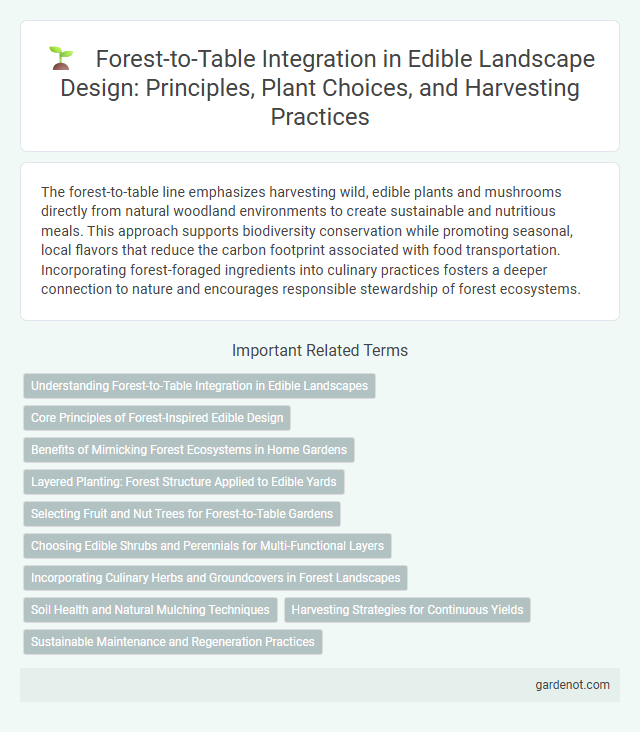The forest-to-table line emphasizes harvesting wild, edible plants and mushrooms directly from natural woodland environments to create sustainable and nutritious meals. This approach supports biodiversity conservation while promoting seasonal, local flavors that reduce the carbon footprint associated with food transportation. Incorporating forest-foraged ingredients into culinary practices fosters a deeper connection to nature and encourages responsible stewardship of forest ecosystems.
Understanding Forest-to-Table Integration in Edible Landscapes
Forest-to-table integration in edible landscapes emphasizes the sustainable harvesting of forest resources directly usable for food, such as wild fruits, nuts, mushrooms, and medicinal plants. This approach enhances biodiversity while promoting a regenerative system that supports local ecosystems and food security. Implementing forest-to-table practices connects foragers and farmers to natural cycles, encouraging stewardship and seasonal dietary diversity.
Core Principles of Forest-Inspired Edible Design
The core principles of forest-inspired edible design emphasize biodiversity, sustainability, and ecological integration by mimicking natural forest ecosystems to create resilient edible landscapes. This approach prioritizes perennial plants, native species, and layered plantings that promote soil health, attract beneficial wildlife, and reduce maintenance. Emphasizing closed-loop nutrient cycling and minimal external inputs fosters a self-sustaining forest-to-table system that supports both human nourishment and ecosystem balance.
Benefits of Mimicking Forest Ecosystems in Home Gardens
Mimicking forest ecosystems in home gardens promotes biodiversity by integrating a variety of edible plants, which enhances soil health and pest resistance naturally. The forest-to-table approach fosters sustainable food production through layered plantings that optimize sunlight, water, and nutrient use. Home gardeners enjoy a resilient, low-maintenance system yielding fresh, nutrient-dense produce year-round.
Layered Planting: Forest Structure Applied to Edible Yards
Layered planting in edible yards mimics natural forest structures by integrating multiple plant layers including canopy trees, understory shrubs, herbs, and ground covers, maximizing space and biodiversity. This forest-to-table approach increases yield by combining fruit trees, nut-bearing plants, and edible perennials within a single ecosystem that supports soil health and pest control. Implementing stratified vegetation enhances resilience to weather variations while providing a continuous harvest of diverse edible crops throughout the growing season.
Selecting Fruit and Nut Trees for Forest-to-Table Gardens
Choosing fruit and nut trees for forest-to-table gardens involves prioritizing species that thrive in your local climate and soil conditions, such as chestnuts, walnuts, and pawpaws in temperate zones. These trees not only provide nutrient-dense harvests but also support biodiversity and soil health through their extensive root systems. Integrating native trees like black walnuts or beach plums enhances resilience and reduces maintenance while maximizing edible yields in a sustainable forest garden design.
Choosing Edible Shrubs and Perennials for Multi-Functional Layers
Selecting edible shrubs and perennials for forest-to-table landscapes enhances biodiversity while providing sustainable food sources throughout the year. Incorporate species like elderberry, blueberry, and hazelnut, which offer nutritional value, habitat benefits, and soil stabilization. Multi-functional planting layers maximize space efficiency and support ecosystem resilience in edible landscape design.
Incorporating Culinary Herbs and Groundcovers in Forest Landscapes
Incorporating culinary herbs and groundcovers into forest-to-table landscapes enhances biodiversity while providing fresh, sustainable ingredients directly from the ecosystem. Species like wild garlic, sweet woodruff, and thyme thrive in shaded, forested environments, enriching soil health and supporting beneficial insects. Integrating these edible plants promotes a symbiotic relationship between forestry and gastronomy, fostering sustainable food sources and ecological resilience.
Soil Health and Natural Mulching Techniques
Forest-to-table practices emphasize soil health by promoting natural mulching techniques such as leaf litter and organic debris from native trees, which enhance nutrient cycling and moisture retention. These methods support microbial diversity and prevent erosion, creating a resilient ecosystem that sustains edible plants. Integrating forest-derived mulch reduces the need for synthetic fertilizers, fostering sustainable, nutrient-rich soils essential for productive edible landscapes.
Harvesting Strategies for Continuous Yields
Implementing staggered harvesting intervals ensures continuous yields in forest-to-table edible landscapes by allowing plants and trees to mature and regenerate without depletion. Integrating diverse species with varying ripening periods maximizes resource use and minimizes harvest gaps. Employing selective pruning and coppicing techniques promotes sustainable growth while maintaining soil health and ecosystem balance.
Sustainable Maintenance and Regeneration Practices
Forest-to-table initiatives emphasize sustainable maintenance and regeneration practices that enhance biodiversity and soil health while providing a continuous supply of edible forest products. Techniques such as selective harvesting, natural mulching, and native species reintroduction ensure ecosystem resilience and long-term productivity. Integrating agroforestry principles supports carbon sequestration and water conservation, promoting a balanced edible landscape.
Forest-to-table line Infographic

 gardenot.com
gardenot.com